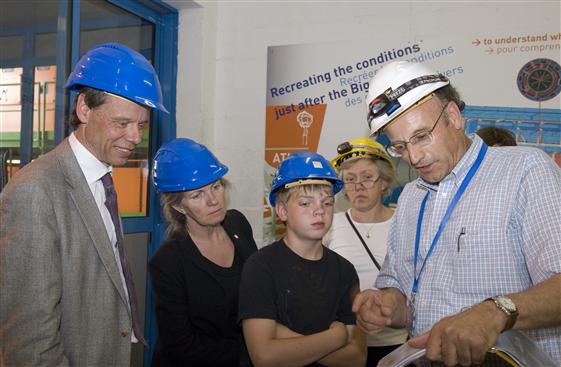Stars in his eyes
The Swedish astronaut Christer Fuglesang, a former CERN physicist now working for ESA, made his debut space flight last December. On 14 June he returned to CERN to talk about the experience.
Does an astronaut make a good cosmic ray detector? A particle physicist is undoubtedly very well placed to answer this kind of question. And as a former CERN physicist and now an astronaut with the European Space Agency (ESA), where he has worked since 1992, Christer Fuglesang has experience of both fields. Last December witnessed his first space journey, a 12-day mission on board the ISS International Space Station (see Bulletin No. 01-02-03/2007), during which he participated in cosmic ray experiments. On 14 June he came to CERN to talk about his experiences in space, giving a lecture on his work for ESA and visiting the ATLAS experiment on which he had worked during his time with the Organization.
In the late 1980s and early 1990s, Christer was successively involved in the UA5, CPLEAR and ATLAS experiments. "Since I left I’ve always kept myself up to date with CERN’s activities and I’ve seen the wonderful photos of the experiments in the press", he explains, although he admits that his work as an astronaut leaves him little spare time to read scientific publications. Even though he knew what to expect from his trip down to the ATLAS cavern, he recounted with great enthusiasm how impressed he had been to see the experiment first hand.
Christer has not completely forgotten his first love. Wanting to combine his interest in physics with his new career as an astronaut, he got in touch with the physicists of the SILEye experiment on the MIR space station which is designed to study the strange phenomenon of light flashes observed by certain astronauts in space. "80% of astronauts have reported this phenomenon", he explains. Caused by cosmic rays, it was first reported during the APOLLO moon missions but the precise mechanism is still unclear. It could be the result of several effects, including the direct interaction of particles with the retina or Cherenkov radiation. "Cherenkov radiation is produced only in very small quantities", underlines Christer. The light flashes seen by the astronauts are very rarely blue, the typical colour of Cherenkov radiation. The hundred or so flashes he personally observed during his flight were all white.
Christer thus went on to study the phenomenon of light flashes, working with the ALTEINO and ALTEA experiments which use an electroencephalogram in conjunction with a cosmic ray detector worn as a helmet to record events occurring right before the astronaut’s eyes. The goal is to establish an objective link between physiological reactions and the events that occur. This research, which is designed to improve our understanding of the effects of cosmic radiation on the body, could prove useful in the context of space travel to the moon or even Mars.
Christer hopes to make another space journey in the next two or three years, perhaps on a longer mission. He would also be keen to fly to the moon in fifteen or so years’ time. He’ll have retired by then but, as he jokingly says, "With the radiation dangers associated with long trips to the moon, it’s better to send old astronauts on such missions!"
Christer Fuglesang’s conference at CERN can be viewed at:



